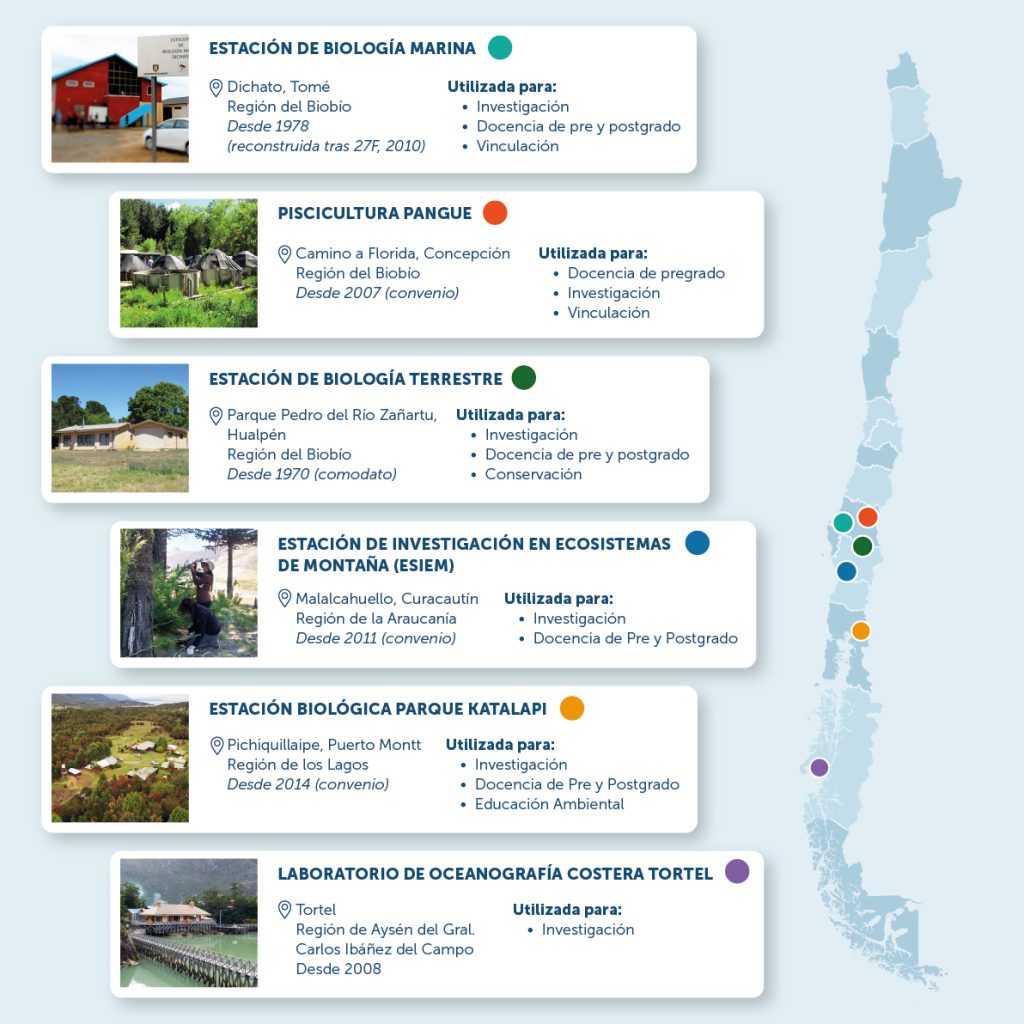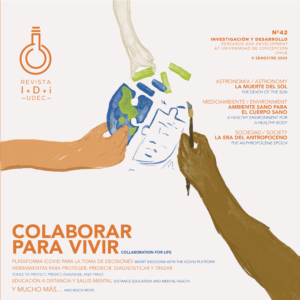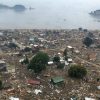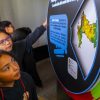By: Paulina Hernández, Faculty of Natural and Oceanographic Sciences / phernandezj@udec.cl | Images: Courtesy of FCNO
Between 1979 and 1985, the University of Concepción’s entire Marine Biology degree program was taught in Dichato. This is because it is home to the Department of Oceanography’s Dichato Marine Biology Station, inaugurated in 1978. Devastated by the 2010 earthquake and tsunami and then rebuilt, today the station is destined for the Faculty’s research and undergraduate degree program’s teaching. The subject of Pelagic Systems was taught from 1997 to 2010 for the Marine Biology and Engineering in Marine Biotechnology and Aquaculture (IBMA, in Spanish) degree programs. However, since 2014, “Introduction to Marine Sciences” and other branches of study such as aquaculture, navigation courses, macroalgae ecology, and deep ocean ecology have been taught there.
Thanks to the Dichato Station, about 4 to 5 projects are materialized yearly, including Fondecyt, Fondef, Fondap, FNDR, and International Projects. Also, about 20 Doctoral theses, 30 Master’s theses, and more than a hundred undergraduate theses have been worked on there. Relevant scientific events, such as international summer courses, are also held there, in addition to different environmental activities, such as talks, exhibitions for schools, and collaborative activities with the Dichato community and artisanal fishers.
The Terrestrial Biology Station in Hualpén, intended for teaching, research, education, and conservation, is a uniquely preserved site representative of Concepción’s coastal area. It has 73 hectares, ceded as a grant by the Government of Talcahuano to UdeC’s Department of Botany in 1970. Undergraduate Biology subjects are taught there. Field trips are also made, and courses from the Faculties of Agronomy and Forestry Sciences are taught there.
Its bountiful resources led to an article by María Moreno-Chacón, Daniela Mardones, Nataly Viveros, Karina Madriaza, Fernando Carrasco-Urra, Alicia Marticorena, Carlos M. Baeza, Roberto Rodríguez, and Alfredo Saldaña, entitled, “Vascular flora of a remnant of coastal Mediterranean sclerophyll forest: Hualpén Terrestrial Biology Station, Biobío Region, Chile,” published in May 2018, in the Gayana Botánica scientific journal. After its publication, an initiative by professors Roberto Rodríguez and Carlos Baeza led to the materialization of a “Field Guide on the Trees of Hualpén Botanical Park.” With the death of Prof. Rodríguez in 2022, this project was taken over by Dr. Baeza and Dr. Lohengrin Cavieres, who worked together with the Institute of Ecology and Biodiversity’s (IEB, in Spanish) communications team in the publication and free dissemination of a printed and digital field guide.
The Mountain Ecosystems Research Station (ESIEM, in Spanish) is in Malalcahuello, Araucanía Region. It was inaugurated in 2011 with the support of the National Forestry Corporation (CONAF, in Spanish) and the Faculties of Forestry Sciences and FCNO. Since then, other faculties have been included, such as Environmental Sciences and Agronomy.
Apart from research and teaching activities, the Station is designed to strengthen collaborations with foreign researchers. The agreement aims to provide CONAF with helpful information for future management and conservation programs.
The Katalapi Park, in the Pichiquillaipe sector in Puerto Montt, is a biological station for the University of Concepción. It is a private initiative of the Corcuera Vliegenthart family, and since November 2020, this Scientific Research and Environmental Education Center has become a Nature Sanctuary in Chile. For over a decade, FCNO’s academic staff and researchers have conducted research there, organized national and international meetings, and guided undergraduate and postgraduate students’ work.

For years, the work of outstanding scientists has made it possible to establish the biodiversity found in Katalapi Park. In this context, the work carried out by researchers from the FCNO’s Botany and Zoology Departments and colleagues from other institutions, who have also conducted studies in the park, is relevant. The place has served as a study site for at least 30 undergraduate and about 10 postgraduate theses. Of all the scientific publications that allude to the flora and fauna found in Katalapi’s ecosystems, researchers from the University of Concepción generated at least 50% of the information that made it possible to obtain the sanctuary decree.
The Caleta Tortel Coastal Oceanography Laboratory in the Aysén Region is a station that investigates fjords and channels in southern Chile. It was built in 2008 thanks to the South-Southern CUPS Program with contributions from CIEP and the Municipality of Tortel. It has a physical space of 36 m2, plus basic equipment, a dock, and a small equipped boat.
In the last decade, it has become a center for ongoing observation of the area through different research projects, such as those related to the dynamics of ichthyoplankton (fish eggs and larvae) and the installation of instruments to continuously measure variables such as temperature, sea level, and salinity, among others.
The artisanal Pangue Fish Farm is on the road to Florida, with the infrastructure needed to grow trout throughout its entire cycle. The university has had ties with the station since 2000, and the collaboration agreement has been in force since 2007.
In these years working with UdeC, Pangue Fish Farm has, directly and indirectly, helped with Fondecyt, Fondef, and CORFO projects, among others, both for FCNO and other faculties. It has become a development center for FCNO alumni’s research projects, implementing them in areas ranging from nutrition, optimization, and innovation in biofilters to disease treatment studies. Different outreach activities have also been implemented with Mapuche communities, artisanal fishers, and technical-professional high schools, among others.








